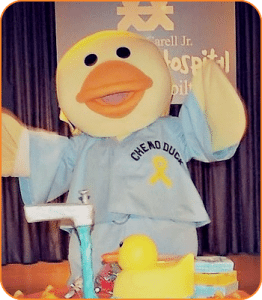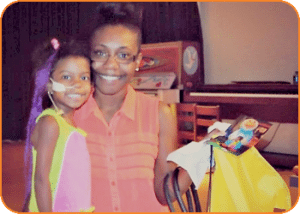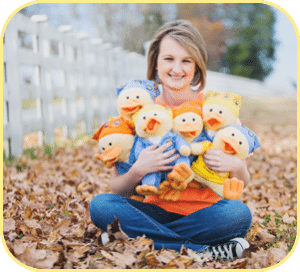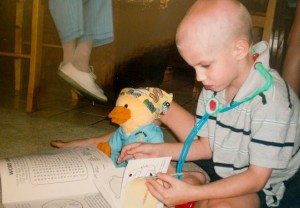Ten years ago, what started as a light-hearted way for one family to cope with the harsh introduction to cancer, has become an international educational tool for patients, families and health care providers.
Chemo Duck, the bright yellow, hospital scrubs and bandana-wearing stuffed animal, has come a long way since it made its first unofficial appearance in 2002.
Lu Sipos’ son, Gabe, was diagnosed in 2002 with rhabdomyosarcoma, a tumor of the muscles that is attached to the bones. For Gabe, the cancer was in the right side of his jaw and sinus passage.
“When I made Gabe’s duck, I was looking for a way to bring some comfort to my child,” said Sipos. “It was also a way to show a little humor for the nurses and doctors,” said Sipos. “I really thought it was a prop that would make them all laugh and then when we went home I’d put it away on a shelf. Fortunately, that is not what happened. The duck ended up becoming a source of comfort for my son as well as a valuable tool used to show Gabe what was going to happen to him during treatments.” 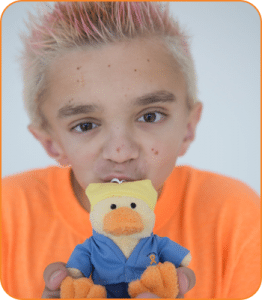
In 2004, Sipos founded the non-profit called Gabe’s My Heart to mass produce Chemo Ducks.
“I never pushed Chemo Duck to grow,” said Sipos. “It grew on its own. It grew out of necessity. Others saw our duck and wanted one. And that led to my making a few and it just caught on.”
Little did Sipos know that the stuffed animal she sewed as an icebreaker during her son’s first visit to the pediatric oncology clinic at the Monroe Carell Jr Children’s Hospital at Vanderbilt would grow into the lovable, source of comfort her then nearly one-year-old son craddled throughout his cancer journey.
Chemo Duck has served as a therapeutic agent for newly diagnosed pediatric patients all across the globe. There have been 2,300 ducks produced.
Chemo Duck is much more than the stuffed animal. Each duck has a catheter sewn into its chest to resemble the line that is central to a chemotherapy patient’s treatment. The educational program comes with a video and two books. The website features cartoons, printable activities and a song. This fall, Sipos expects to launch a Chemo Duck app.
What makes celebrating the ten-year mark with Chemo Duck more special, says Sipos, is that Gabe is taking a very active role in the program that was initially created for him.
Recently, the 12-year-old received regional recognition through the Kohls Kids Care Scholarship for his volunteer work.
“I am really proud of his becoming more a part of the program,” said Sipos. “I feel so glad that he is getting recognized for the work that he is doing. The idea that he wants to be a part of this and wants to give back makes me proud as a parent.”
As a voting member of the board of directors for Gabe’s My Heart, Gabe has had several opportunities to interact with the public and explain the Chemo Duck program.
“He has taken a real interest in our events and especially working with the kids,” said Sipos. “That is an area where he excels. He is a natural when it comes to interacting with people.”
As Chemo Duck celebrates 10 years of providing necessary information for patients, families and practitioners, Sipos shares one of her dreams:
“Now, I want Chemo Duck to be to kids with cancer what Mickey Mouse is to all kids – something that creates a smile on a child’s face.”
As part of the anniversary celebration, Chemo Duck will host a birthday party at Children’s Hospital on August 6 at 2:30 p.m. at the stage. Fans are also invited to submit birthday greetings by posting a creative, fun or inspiring photo or video message to Chemo Duck’s Facebook page. Post between August 5 and August 10 at midnight. A winner will be announced on the Facebook page on August 13 (the actual 10th birthdate) and will receive a $100.00gift card to Amazon.com and have 10 Chemo Ducks donated to a hospital of their choice.
